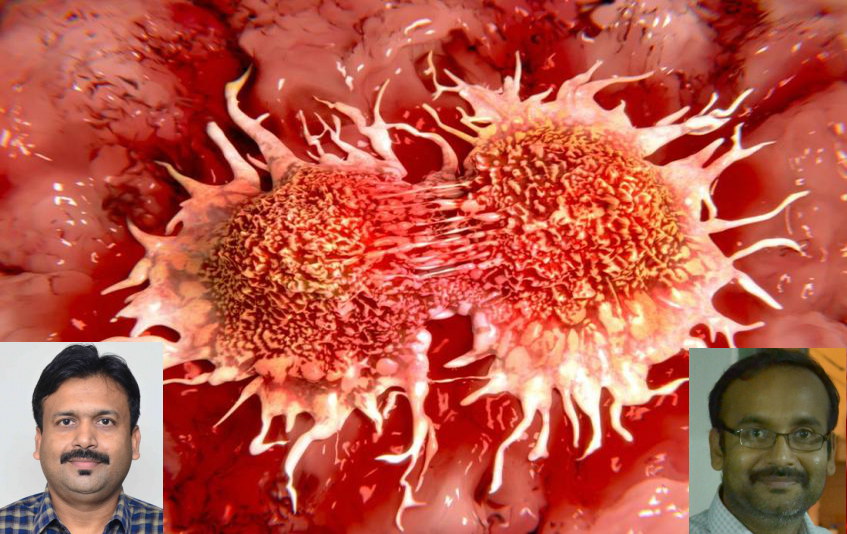IIT Roorkee researchers develop new technique for treatment of cancer
-Navneet Kumar Gupta
Today Cancer is one of the leading causes of morbidity and mortality worldwide. According to statistics, incidence of cancer in India alone is 70-90 per 1,00,000 population and it is estimated that there are over 2.5 million cases of cancer annually with over 800,000 new cases and 5,50,000 deaths occurring each year.
Cancer is known to afflict almost all parts of the body and there are over 100 different known cancers that affect humans. According to experts, the five most common cancers worldwide are lung, breast, bowel, prostate & stomach.
Recently, researchers at the Indian Institute of Technology Roorkee have discovered a new method of treating cancer, an ever-increasing disease burden across the world. The collaborative effort by Dr. Kaushik Ghosh from the Department of Chemistry and Dr. Prabhat Mandal, Department of Biotechnology has unravelled the use of a nitrosyl compound, which releases nitric oxide into the afflicted area under visible light. The method called Photodynamic Therapy works on the concept of targeted drug delivery into the afflicted area, with the use of light. Research has shown that Nitric Oxide (NO) has anti-cancer properties and research groups have explored the different types of photoactive ruthenium nitrosyl complexes for treatment. However, most of the ruthenium nitrosyl complexes delivered the Nitric Oxide only in the presence of Ultra Violet (UV) light, which is a major drawback for their use in biological experiments.
Since UV Light is intrinsically harmful to cellular targets, the team looked at an alternative of working with other metal-nitrosyls, which can be used under visible light for the release of Nitric Oxide. The researchers worked on an organometallic ruthenium nitrosyl complex containing azo group capable of releasing Nitric Oxide in the presence of visible light very quickly. The team used the extreme end of the visible light spectrum at 800 nm, to induce skin penetration and Nitric Oxide release. The released Nitric Oxide under visible light was utilized to investigate the anti-proliferation activity studies on human (A549 and HEK 293T), mouse (NIH3T3) and HeLa cancer cell-lines. Results showed that the photo-released Nitric Oxide was cytotoxic and was responsible for death of the cancerous cells.
[post_ads]
Talking about the research, Dr. Kaushik Ghosh from the Department of Chemistry at IIT Roorkee said, “In current times, the use of UV or other range of radiation is synonymous with cancer treatment across the world. However, the use of such radiation is harmful to the cells across the body. Moreover, medicines which are orally taken to treat cancer also have extreme negative effects on human body. Our concept was to look at a method through which we can deliver the drug in a non-toxic way, only to the area which is affected by cancer, thereby reducing the effect of the medicines on the remaining body.”
In recent years, target specific delivery of Nitric Oxide has become an important area in chemical as well as biochemical research. Molecules which could deliver Nitric Oxide upon illumination with light are important for photodynamic therapy. However, no one had tried it under the spectrum of visible light. We used the extreme end of the spectrum of visible light to induce the release of Nitric Oxide and the results have been positive. Such interesting results are of extreme interest in photodynamic therapy and we hope that there will be further investigations on the use of such activity in treatment of other diseases as well.
------------------
 Navneet Kumar Gupta is a science communicator working as a Project Officer (Edusat) in Vigyan Prasar-National institute of Science communication under the Department. of Science & Technology. Govt. Of India. He has deep interest in popular science writing for general public through Print and electronic media. Besides his twelve books, he has written more than 200 popular science articles. He has edited/authored/co-authored more than 10 books. He have been awarded six National Awards including Rajbhasha Award, Ministry of Home Affairs, Government of India He has had a long stint as Associate Editor, VIPNET news - a popular science magazine. You may contact him at - ngupta@vigyanprasar.gov.in
Navneet Kumar Gupta is a science communicator working as a Project Officer (Edusat) in Vigyan Prasar-National institute of Science communication under the Department. of Science & Technology. Govt. Of India. He has deep interest in popular science writing for general public through Print and electronic media. Besides his twelve books, he has written more than 200 popular science articles. He has edited/authored/co-authored more than 10 books. He have been awarded six National Awards including Rajbhasha Award, Ministry of Home Affairs, Government of India He has had a long stint as Associate Editor, VIPNET news - a popular science magazine. You may contact him at - ngupta@vigyanprasar.gov.in
